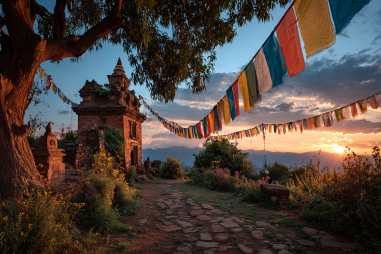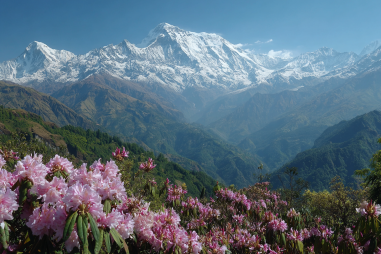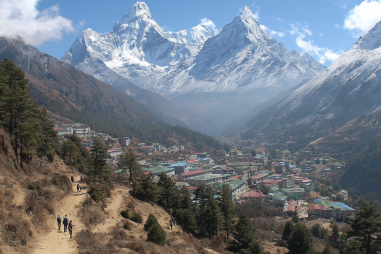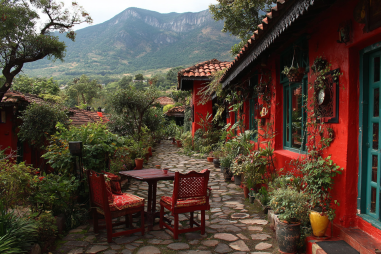Nestled in the heart of the Himalayas, Namche Bazaar is widely known as the cultural and commercial hub for trekkers heading to Everest Base Camp. But beyond its bustling markets and vibrant Sherpa culture, Namche Bazaar offers an extraordinary window into a world of natural beauty and wildlife diversity. Surrounded by towering peaks and part of the Sagarmatha National Park, it provides nature lovers with a unique chance to observe rare animals, exotic birds, and an array of alpine flora that few other places in the world can match. Whether you’re here to soak in the panoramic views or keen on spotting elusive wildlife, the natural wonders of Namche Bazaar are sure to leave you spellbound.
Exploring Namche Bazaar’s Natural Environment
Located at an elevation of about 3,440 meters (11,286 feet), Namche Bazaar sits in a stunning high-altitude environment where the rugged Himalayas begin to give way to rich valleys and forested slopes. The area’s landscape is dramatically shaped by the surrounding snow-capped peaks and deep river gorges, which create microclimates that support diverse ecosystems. The thick rhododendron and coniferous forests that cloak the hillsides are home to many endemic species of flora and fauna adapted to this harsh but beautiful terrain. As the main gateway for trekkers entering the Sagarmatha National Park, Namche is perfectly positioned for visitors to experience the region’s unique biodiversity first-hand.
Common Mammals: Himalayan Tahr and Musk Deer
One of the most exciting aspects of visiting Namche Bazaar is the opportunity to spot its distinct mammals. Two particularly fascinating species are the Himalayan tahr and the musk deer, both adapted to survive in the mountainous environment.
- Himalayan Tahr: The Himalayan tahr is a sturdy wild goat with a thick, reddish-brown coat that helps it endure cold temperatures and steep rocky slopes. These agile animals are most commonly seen grazing on alpine meadows during the warmer months. They move swiftly and expertly across craggy terrain, making them a favorite among wildlife photographers and trekkers alike.
- Musk Deer: Far more elusive than the tahr, musk deer are nocturnal and shy, making them harder to spot. Known for their distinctive musk glands, which unfortunately have led to illegal hunting, musk deer inhabit dense forested areas. Their unique appearance, featuring fangs or “tusks” protruding from the males, adds to their mystique. Sightings are rare but rewarding for those who are patient and attentive.
Birdwatching Highlights in Namche
Birdwatchers will find Namche Bazaar’s surroundings to be an avian paradise. The mix of forest, shrubland, and alpine habitats attracts a variety of bird species, some of which are endemic to the Himalayan region. Early mornings often bring melodious bird calls that enhance the trekking experience. Some notable bird species include:
- Himalayan Monal: The vibrant national bird of Nepal, known for its iridescent plumage, is sometimes spotted in the region’s forests. Though shy, their dazzling colors make for a remarkable sight.
- Snow Pigeon: Often seen in flocks, these birds inhabit rocky areas and are easier to spot thanks to their distinctive markings.
- Lammergeier (Bearded Vulture): This large scavenger is famous for its dramatic flight and unique habit of dropping bones onto rocks to crack them open.
- Chestnut-breasted Partridge: A rare and elusive undergrowth dweller that calls the rhododendron forests home.
With a good pair of binoculars and a keen eye, bird lovers can enjoy an unforgettable wildlife-watching experience in Namche.
The Unique Plants and Alpine Flora of the Region
The flora around Namche Bazaar is just as captivating as its fauna. The region boasts a rich variety of alpine plants and colorful wildflowers that bloom in the spring and summer months, painting the hillsides in vivid reds, pinks, whites, and purples. Among the more notable plants are:
- Rhododendrons: These striking shrubs are common in the region and come in numerous species. During blooming season, they cover the forest floor and hills in breathtaking colors.
- Blue Poppy: Often called the national flower of Bhutan and found here as well, the Himalayan blue poppy is admired for its rare and delicate beauty.
- Juniper and Birch Trees: These hardy trees thrive in the alpine zone and are used locally for various traditional purposes.
- Medicinal Herbs: The region is rich in plants used in traditional medicine, some of which are now being studied for their pharmaceutical potential.
For botany enthusiasts, trekking around Namche offers a fascinating glimpse into the resilience and beauty of high-altitude flora.
Conservation Efforts in Sagarmatha National Park
Namche Bazaar lies within the boundaries of Sagarmatha National Park, a UNESCO World Heritage Site established in 1976 to protect the unique Himalayan ecosystem. Over the years, conservation has become a shared priority among local communities, trekkers, and the Nepalese government. Some key efforts include:
- Strict regulations on waste disposal to maintain the park’s pristine condition.
- Anti-poaching patrols aimed at protecting endangered species like the musk deer and snow leopard.
- Environmental education programs for local Sherpa communities and visiting tourists.
- Promotion of sustainable tourism practices that minimize ecological footprints.
These conservation initiatives help ensure that the natural treasures of Namche Bazaar are preserved for future generations to enjoy.
Best Spots for Wildlife Viewing Around Namche Bazaar
If you’re eager to spot wildlife, certain locations around Namche offer better chances than others. Here are some top spots and tips to enhance your viewing experience:
- Sagarmatha National Park Trails: Many trekking routes within the park pass through forest patches and alpine meadows frequented by Himalayan tahr and various bird species.
- Khumbu Valley: The valley stretches around Namche and is home to diverse flora and fauna, often visible during early morning or late afternoon hikes.
- Nearby Villages and Forested Areas: Quiet side trails away from large groups increase the chances of spotting shy animals like musk deer.
- Observation Points: Elevated clearings, such as those near the town center or viewpoint terraces, offer sweeping views where birds of prey can be observed soaring overhead.
Bringing a good pair of binoculars and moving quietly can significantly improve your opportunities to connect with the local wildlife.
Eco-Friendly Travel Tips for Nature Lovers
To help protect the fragile ecosystem of Namche Bazaar and its surrounds, travelers should consider adopting eco-friendly habits during their visit. Here are some practical tips:
- Pack Out What You Pack In: Avoid leaving litter behind by carrying out all your trash, including biodegradable waste where required.
- Use Reusable Items: Bring reusable water bottles, bags, and utensils to reduce plastic waste in the area.
- Stick to Established Trails: Minimize environmental impact by staying on marked paths and avoiding trampling on vegetation.
- Respect Wildlife: Observe animals from a distance without disturbing them or their natural behaviors.
- Support Local Conservation Efforts: Contribute to community-based programs or purchase products that benefit ecological protection projects.
By traveling responsibly, you can help ensure that Namche Bazaar’s natural beauty remains intact and thriving.
Appreciating and Protecting Namche Bazaar’s Natural Heritage
Namche Bazaar is more than a trekking stopover — it is a realm where nature’s magnificence unfolds in every direction. From the wild goats clambering on rugged cliffs to the kaleidoscope of alpine flowers blooming along mountain trails, the wildlife and natural wonders of this Himalayan gateway embody the spirit of adventure and conservation. For those who visit with open eyes and respectful hearts, Namche offers a rare chance to witness a delicate ecosystem thriving against all odds. As you explore and appreciate this stunning landscape, remember that preserving its pristine beauty is a shared responsibility — one that allows future generations of travelers and nature lovers to experience the magic of Namche Bazaar’s wild and wonderful world.







